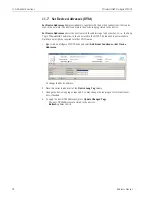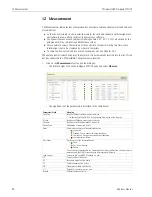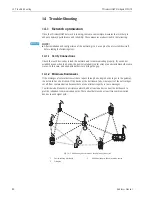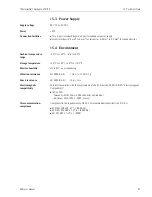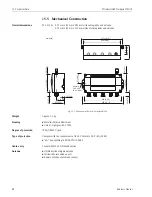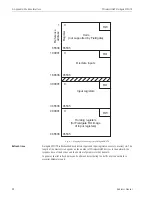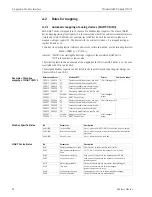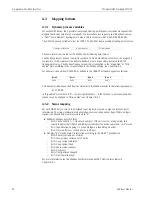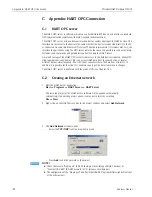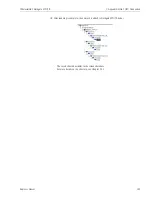
A Appendix: Modbus Interface
WirelessHART Fieldgate SWG70
90
Hauser
A
Appendix: Modbus Interface
A.1
Introduction
A.1.1
Modbus protocol
Modbus is a quasi-industrial standard developed some years ago by Gould-Modicon and provides a
messaging service that may run on a variety of physical layers. For Fieldgate SWG70 there are two
possibilities for connecting Modbus:
• Modbus RTU (also known as Serial) can be connected point-to-point to the RS-485C interface
as described in Chapter 5.4.
• Modbus TCP (also known as Modbus TCP/IP) can be connected to an Ethernet Interface as
described in Chapter 5.3.
The Modbus protocol exchanges data in a master-slave relationship. Each slave has a unique
address, and the data are identified by their location in the slave address register. Certain
characteristics of the Modbus protocol are fixed, such as the frame format, frame sequences,
handling of communications errors, exception conditions and the functions performed. Other
characteristics are user selectable; these include transmission medium, baudrate, character parity,
number of stop bits, and transmission modes. Chapter 8.3 describes how both Ethernet and Serial
interfaces can be set up. The contents of the data carried by the protocol are also freely selectable,
i.e. nothing is said about strings, integers, floating-point numbers etc.
The Modbus protocol controls the query and response cycle between master and slave devices. Only
the master can initiate a transaction. A query and response may involve only a single slave, or it may
be in the form of a broadcast, in which case the slaves do not answer. The query is contained in a
frame that includes the address of the intended receiver, what this slave is to do, data needed to
perform the action, and a means of checking for errors. The slave checks if errors have occurred and
performs the desired action. After the action is performed the slave builds the response and returns
it to the master. The master can send another message to any slave as soon as it receives a valid
response or after a user-selected time interval. This "timeout" period has to be selected on the master
device and depends on the slave response time.
Data can be exchanged in two transmission modes: ASCII (American Standard Code for Information
Interchange) and RTU (Remote Terminal Unit). The major differences between them are the type
of error check performed on the message and the number of characters used. Fieldgate SWG70
supports RTU only. Modbus offers several read, write and test functions, each identified by a code
number. They are designed as control commands for sensors and actuators, e.g. coils, inputs, input
registers, holding or output registers, diagnosis and test reports, programs, polling control and reset.
For Modbus TCP the serial frame is simply inserted into the Ethernet data frame. In addition, not
all codes are implemented.
Modbus overview
Modbus RTU
Modbus TCP
Standard compliance
"Modbus over Serial Line" V1
"Modbus over TCP" V1
Physical layer
RS-485
Ethernet
Transmission mode
RTU (binary mode)
TCP
Baudrates
1200 bit/s, 2400 bit/s, 4800 bit/s,
9600 bit/s, 19200 bit/s, 38400 bit/s,
57600 bit/s, 115200 bit/s
100 MBit/s
Partiy
Odd, Even, None
–
Stop bits
1; 1.5; 2
–
Polling address
1...247
–
Port No.
–
502
Capabilities
• Input registers starting at Modbus address 30013
• HART Command 3 dynamic variables mapped into input registers
• 2 input registers map a single HART dynamic variable
• 32bit HART floating point format used
• Status information mapped on dedicated input registers
Summary of Contents for Fieldgate SWG70
Page 2: ......
Page 119: ...WirelessHART Fieldgate SWG70 D Appendix ANATEL Approval Endress Hauser 117 For your notes ...
Page 120: ...D Appendix ANATEL Approval WirelessHART Fieldgate SWG70 118 Endress Hauser For your notes ...
Page 121: ...WirelessHART Fieldgate SWG70 D Appendix ANATEL Approval Endress Hauser 119 For your notes ...
Page 123: ......
Page 124: ...www endress com worldwide ...



